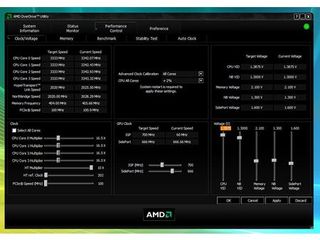AMD 790GX: RV610 For Enthusiasts?
Overclocking
Overclocking on 790GX takes a slightly different form that it did on any previous AMD-based chipset as a direct result of the Advanced Clock Calibration feature introduced with the SB750 southbridge. Rather than simply tweaking and tuning multipliers, interconnect speeds, voltages, and timings, there’s one step interjected between running at stock speeds and picking an overclocking target.
Mainly, that step involves enabling ACC, either through a motherboard BIOS or using the OverDrive utility, and choosing a “value” corresponding to ACC. The value in question ranges from -12% to +12% and starts at zero. What exactly does it represent? Good question — AMD is staying deliberately quiet on the exact definition. However, all indications point to the loosening and tightening of tolerances. With a Phenom X4 9950 or 9850, AMD recommends opening ACC up to +2% or so. A slower chip, like an older 9600, might be able to withstand +4% or +6%. You get the idea.
AMD says that ACC will help improve the overclocking headroom of any Phenom chip, though it recommends Black Edition CPUs most highly. Perhaps that’s because it can be so challenging to get stable overclocks out of the HT reference clock alone.
With ACC turned on and set to the “margin” of your choosing, it’s business as usual. Drop down into OverDrive and start tweaking the settings you’d normally use to tune your processor. It’s a good idea to start with a good reference point if you’re really interested in the effects of ACC. We went with a Phenom X4 9850 that, prior to ACC and installed in a Gigabyte MA790FX-DQ6, wouldn’t break past 2.8 GHz using stock cooling and voltages as high as 1.35V.

Skepticism was swept aside when, on the Gigabyte MA790GP-DS4H and using a 1.35V setting, we were able to hit 3.28 GHz with a 205 MHz HT ref. clock. AMD claims ACC will buy most processors between 100 and 400 MHz on top of what they could do sans ACC. Our 430 MHz (beyond 2.8 GHz) overclock falls right in line with those results. After taking a lot of heat for less than stellar scalability, 700+ MHz tweaks should earn AMD’s Black Edition CPUs quite a bit more respect in the overclocking community — so long as ACC doesn’t turn out to make an impact on stability over the long term.
We tried playing with different ACC values (4% and 6%), but didn’t notice any appreciable improvement in headroom. Although we were able to operate well into the 3.3 GHz range, the system didn’t take long to crash once a load was applied to it. With a larger cooler and a bit more juice, 3.4 GHz would have likely been achievable.
Stay on the Cutting Edge
Join the experts who read Tom's Hardware for the inside track on enthusiast PC tech news — and have for over 25 years. We'll send breaking news and in-depth reviews of CPUs, GPUs, AI, maker hardware and more straight to your inbox.
-
kitsilencer Great review, and it's good to see that AMD is at last able to target more enthusiast markets competitively.Reply -
cangelini kitsilencerGreat review, and it's good to see that AMD is at last able to target more enthusiast markets competitively.Reply
Thanks for the feedback Kit. -
waffle911 So... why does a page 15 and 16 of this article exist if there is no page 15 or 16 to the article?Reply
Take a closer look. What happened? -
YYD PCMark seems Intel biased, please read this:Reply
http://arstechnica.com/reviews/hardware/atom-nano-review.ars/6
Please change this benchmark suite or check if PcMark Vantage is unbiased. -
cangelini waffle911So... why does a page 15 and 16 of this article exist if there is no page 15 or 16 to the article?Take a closer look. What happened?Reply
That was strange. Should be fixed now.
-
cangelini YYDPCMark seems Intel biased, please read this:http://arstechnica.com/reviews/har view.ars/6Please change this benchmark suite or check if PcMark Vantage is unbiased.Reply
Fortunately, with no Intel platforms tested, this should be a non-issue for the current situation ;-) In the future, you'll be seeing SYSmark, though. -
Seems past page 8 or something the links are corrupt.. can't fully read this article and getting error 404 - page not found.Reply
-
cangelini lacrits.. and now the article seems to be removed even from the main page!?!?!Reply
Alright, mystery solved. It's back up, sans the blank page. Thanks for pointing that out lacrits!
Most Popular


